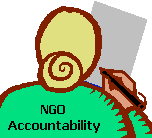Logistics of Success
The International Federation of Red Cross and Red Crescent Societies-IFRC won the prestigious European Supply Chain Award for 2006 in the non-profit and also overall category. No small achievement considering that the previous winners of this award have included Coca-Cola, Dell and Johnson & Johnson. For the rest of us in the nonprofit sector, the win draws attention to a 'reflective question' - what gave IFRC operations an edge over such professional and savvy corporations?
From delivery of relief during disasters, channelizing micro-finance, maximizing revenues from donated goods to the supply of products made by income-generation projects - the need for fast, efficient, secure and economical logistics system is crucial. [Delivering the Goods: Rethinking Humanitarian Logistics]
From delivery of relief during disasters, channelizing micro-finance, maximizing revenues from donated goods to the supply of products made by income-generation projects - the need for fast, efficient, secure and economical logistics system is crucial. [Delivering the Goods: Rethinking Humanitarian Logistics]
If these systems are so critical to the results of the program, then are we (in the nonprofit sector) giving them due priority? Adequately investing in these systems and the skills needed for their operation?
As is the case with most other questions facing the nonprofit sector, a definitive 'yes' or 'no' answer would be difficult and also not appropriate. For, there are organizations that have integrated innovative supply chain solutions. But, unlike the corporate sector which is constantly upgrading to stay competitive, the non-profit organizations find it difficult to sustain investments in the world of rapidly advancing technology. Compounding this constraint in effective leveraging of technology is the general preference of funding direct relief over investment in infrastructure and shortage of skilled professionals. Though if the number of job advertisements for logistics and supply chain management functions are an indication, then the nonprofit sector is surely lengthening the chain..... [From Logistics to Supply Chain Management: The Path forward in the Humanitarian Sector]
As is the case with most other questions facing the nonprofit sector, a definitive 'yes' or 'no' answer would be difficult and also not appropriate. For, there are organizations that have integrated innovative supply chain solutions. But, unlike the corporate sector which is constantly upgrading to stay competitive, the non-profit organizations find it difficult to sustain investments in the world of rapidly advancing technology. Compounding this constraint in effective leveraging of technology is the general preference of funding direct relief over investment in infrastructure and shortage of skilled professionals. Though if the number of job advertisements for logistics and supply chain management functions are an indication, then the nonprofit sector is surely lengthening the chain..... [From Logistics to Supply Chain Management: The Path forward in the Humanitarian Sector]








